15+ Interesting Employee Productivity Statistics 2023 That You Need To Know
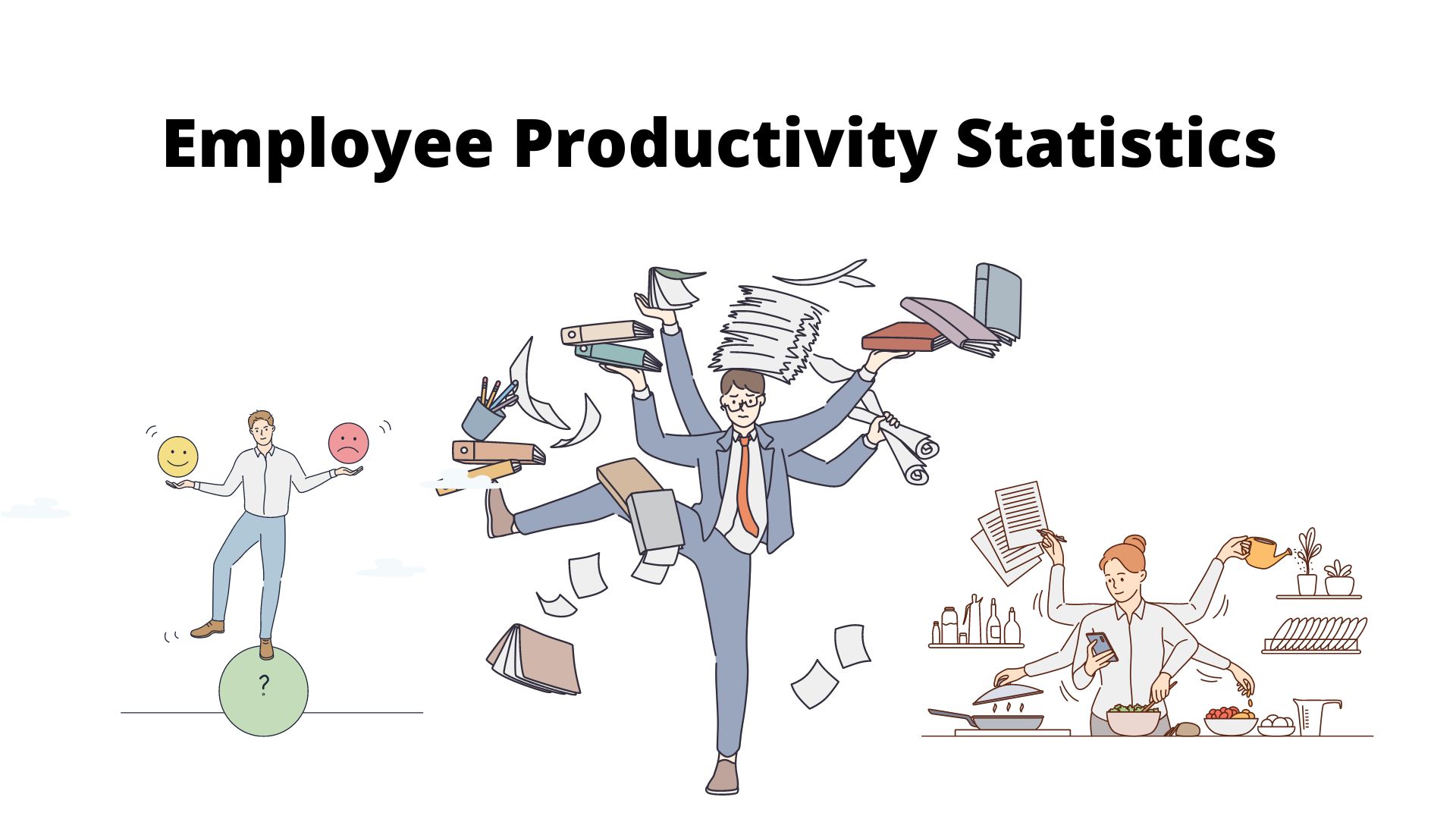
Page Contents
- Key Productivity Statistics (Editor's Choice)
- General Employee Productivity Statistics
- Self-Reported Employee Productivity Statistics
- Employer Productivity Statistics
- Factors for Improving Employee Productivity Statistics
- Employee Productive Statistics by Countries
- Employee Productivity over Time Statistics
- Conclusion
Employee Productivity Statistics: WhatIs.com defines worker productivity as “an assessment of the efficiency of a group of employees or employees.
Worker productivity measures the value of an employee's work for a firm in a given period. If businesses are to prosper, they want highly productive workers.
This article will discuss helpful and incredible Productivity Facts and Statistics. Hopefully, you can use these productivity stats to establish new policies within your company and increase the overall efficiency of your workforce.
Key Productivity Statistics (Editor's Choice)
- Freelance employees are productive for up to 87% of their working day.
- 23%of employees who are actively engaged at work are more productive.
- As of 2023, nearly 5.8% of workday waste can take place due to a single distraction.
- Throughout a working day, actively engaged employees experience less workplace stress by 44%.
- Fewer meetings result in more productive outcomes said 70% of employees.
- The most productive day of the week is Tuesday where the log-on time is 6 hours and 44 minutes.
- The highest focus time is observed on Monday (4 hours and 42 minutes) and Friday (4 hours and 24 minutes).
- Only 7% of workers say they feel productive at the workplace.
- Productive businesses have around 48% higher operating margins than less productive companies.
- Approximately 24 billion hours are wasted annually as a result of fruitless meetings.
- On average, employees are 13% more productive when working remotely, and overall employee productivity in the United States has grown by 5% since the pandemic began.
- After a distraction, concentrating on the task usually takes 23 minutes and 15 seconds.
- The average worker is productive for 2 hours & 53 minutes per day. That only accounts for 31% of an average 8-hour workday.
- In each working day, an average of 6 hours and 59 minutes turned out productive for digital workers.
- AI and Automation are used by more productive workers are 242% and 78% respectively.
- In the United States, 91% of employees have accepted that they remained more engaged at work.
- Around 41% of employees claim that stress makes them less productive.
- 80% of workers report feeling stressed out due to ineffective organizational communication.
- Workers spend up to 32% of their time on the Facebook- social media platform, which employs $28 billion annually.
General Employee Productivity Statistics
Of course, no worker or business is equally productive to the fullest extent. In the larger picture, some factors can make some workers more productive than others. These are some of the insights that our research revealed:
#1. Freelance employees are productive for up to 87% of their working day.
Assuming that a freelancer is working 5 days a week, the fact that they work an average of 36 hours a week means they are productive for a minimum of 7 hours each day.
#2. Even though remote workers are productive for 60% of their workday, office workers are only productive for 31% of their workday.
For the remote worker, that equates to nearly 4.8 hours of productivity each day. However, that figure is only 2 hours and 53 minutes for office workers, or just 12.5 hours a week.
#3. Employees who are actively engaged are 21% more productive.
High employee engagement is actually a big plus because these teams experience a 59% drop in turnover, a 41% drop in absenteeism, and a nearly 28% drop in internal theft.
Self-Reported Employee Productivity Statistics
Although the daily productivity of workers may seem surprisingly low, how do workers think about their productivity? Their thoughts are as follows:
#4. 66% of workers believe they would be more productive if they worked from home.
This conclusion is mainly based on the fact that around 76% of workers desire fewer interruptions from coworkers and other distractions, nearly 70% of employees want to reduce stress from commuting, and 69% want to stay away from workplace politics.
#5. Only 7% of workers say they feel productive at the workplace.
This is consistent with the fact that workers are productive only for 2 hours & 53 minutes each day. Likely, the majority of workers probably feel unproductive because they spend most of their workday distracted.
As of 2023, effective employee productivity tools used are Email (61%), the Internet (54%), Landline phone (35%), and Smartphone (24%).
#6. 46% of workers believe that digital tools make them more productive.
Just 7% of employees think that technology has lowered their level of productivity. These workers say that the two significant digital tools they use are email (around 61% of workers say that it is essential) and the internet (roughly 54% of employees say it is the most important), are the two most significant digital tools they use.
As of 2023, a positive digital experience is the success key for 80% of employees.
According to the National Bureau of Economic Research, employee productivity has increased by 14% after implementing Artificial Intelligence.
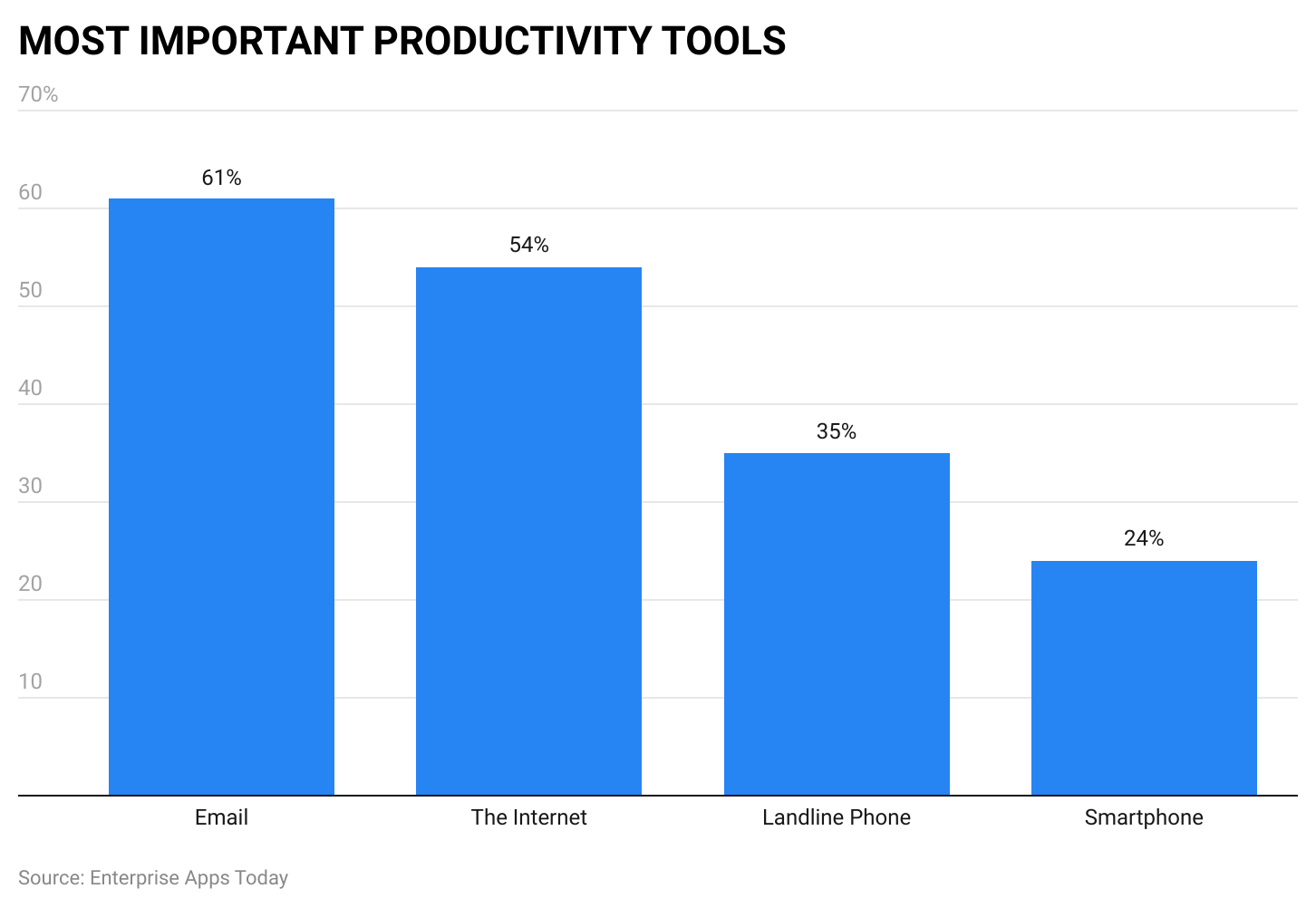 (Source: Zippia.com)
(Source: Zippia.com)
Employer Productivity Statistics
We now know what workers think about their productivity; it is time to examine how companies see the situation. Are they making any efforts to solve the issue, or are they just making it worse? Our analysis reveals that:
#7. Approximately 31 hours per month are wasted annually as a result of fruitless meetings.
Nearly 37% of workers believe that unproductive meetings are the most significant expense for their company. Unsurprisingly, 24 billion represents a substantial amount of productive work hours lost.
Due to cancellations and unnecessary meetings, almost 71% of employees waste their time every week.
#8. Productive companies have almost 30% to 50% higher operating margins than less productive companies.
Research shows that the best businesses are up to 40% more productive than other businesses. It means that productivity is even more crucial than overall efficiency.
#9. The average corporate worker spends approximately 4 – 5 hours per week preparing for & attending meetings, 2023.
Around 54% of workers claim that their meetings last longer than 30 minutes. Additionally, 35% of workers concur that the 2 to 5 hours are wasted on meetings every week, and they are not receiving any benefits.
#10. 76% of workers think that organization-provided wearable technology to track workers would assist in improving productivity.
However, it seems that many workers are worried about how their companies would use their health and fitness information.
The Top Productivity Issue
It is crucial to understand the primary causes of lower productivity in order to address the existing situation of worker productivity. After all, a few distractions can be more harmful than others. These are the facts:
#11. The average worker spends nearly 2.35 hours on social media each day or up to 32% of their workday.
Facebook is one of the main offenders, costing businesses a startling $28 billion in productivity losses every year.
#12. 80% of workers report feeling stressed out due to ineffective organizational communication.
This number seems to increase by around 30% from 2018 to 2019. Communication barriers within organizations can cost an average of $26,000 annually.
#13. Multitasking may reduce productivity by up to 40%.
Actually, even the concept of multitasking is a myth because 98% of people can't multitask or have difficulty multitasking. Given this context, it should come as no surprise that trying to multitask can reduce productivity.
#14. Using social media is also the most prominent and common distraction, with approximately 37% of workers checking it while at the workplace.
Other typical office distractions include talking about out-of-work activities with coworkers (38% of workers), reading news sites (45% of workers), taking smoking breaks (28% of workers), and making hot beverages (31% of workers).
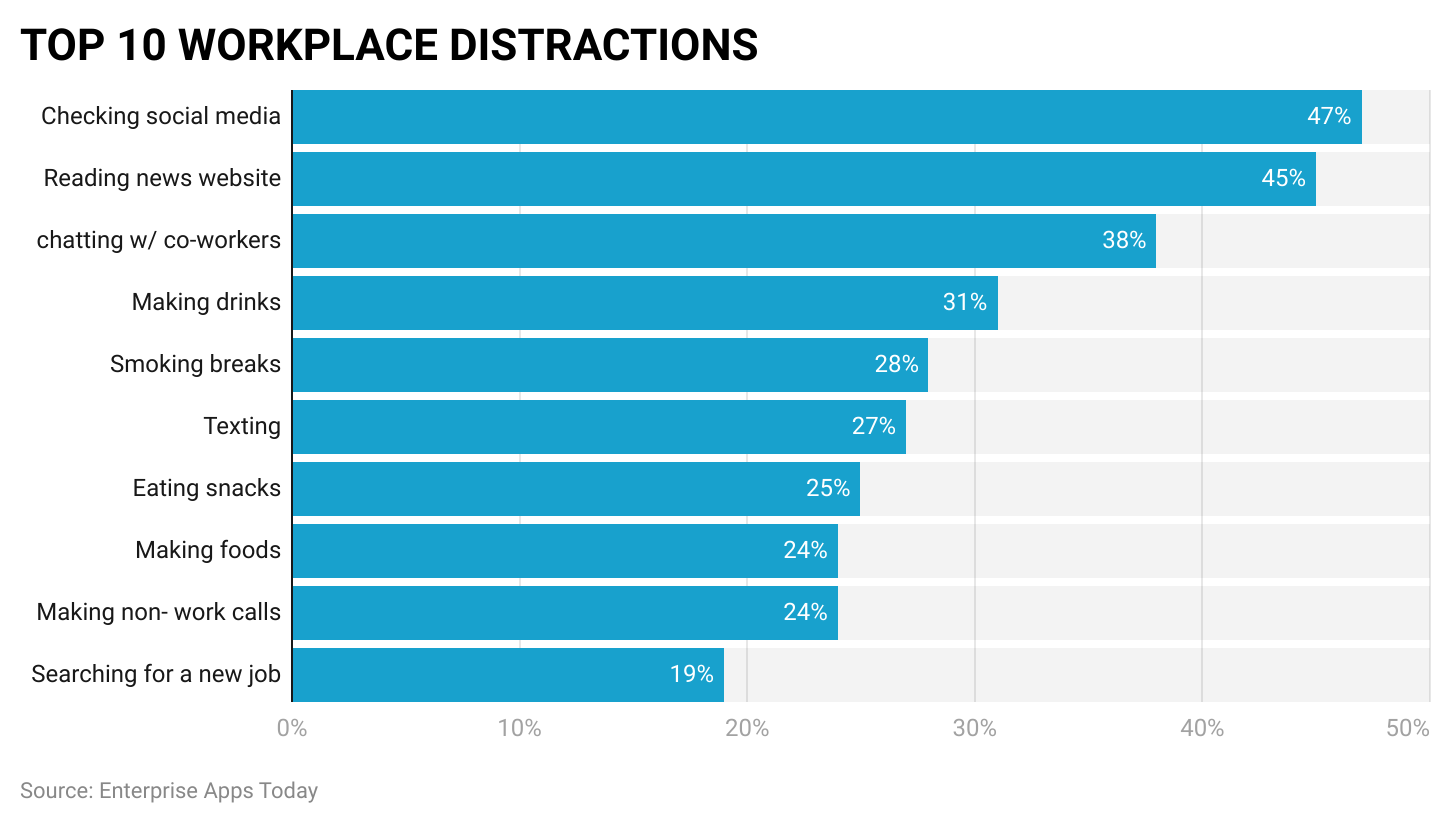 (Source: Zippia.com)
(Source: Zippia.com)
#15. After a distraction, concentrating on the task usually takes around 23 minutes and 15 seconds.
This is bad news considering that the average worker is interrupted every 3 minutes and 5 seconds. It is not surprising that per-day productivity is so low.
#16. Less than 25% of workers prefer to work in groups.
This could impact productivity because, over the previous 5 years, workers report that the significant time spent on phone conversations, in meetings, or responding to emails has risen by 50% and now takes nearly 80% of their time.
#17. 70% of workers acknowledge being distracted at work.
Roughly 16% of respondents claim to be frequently distracted, and 54% of workers believe they are not performing at their best.
Factors for Improving Employee Productivity Statistics
- The company’s wellness program helped enhance health benefits along with improving productivity and job satisfaction, as claimed by 61% of workers.
- Only 20% of workers felt more valued at their workplace due to recognition that also allows for improved productivity.
- Happiness in employees results in increasing productivity rate by 12%.
- Another way to increase job performance by 25% is proper nutrition.
Employee Productive Statistics by Countries
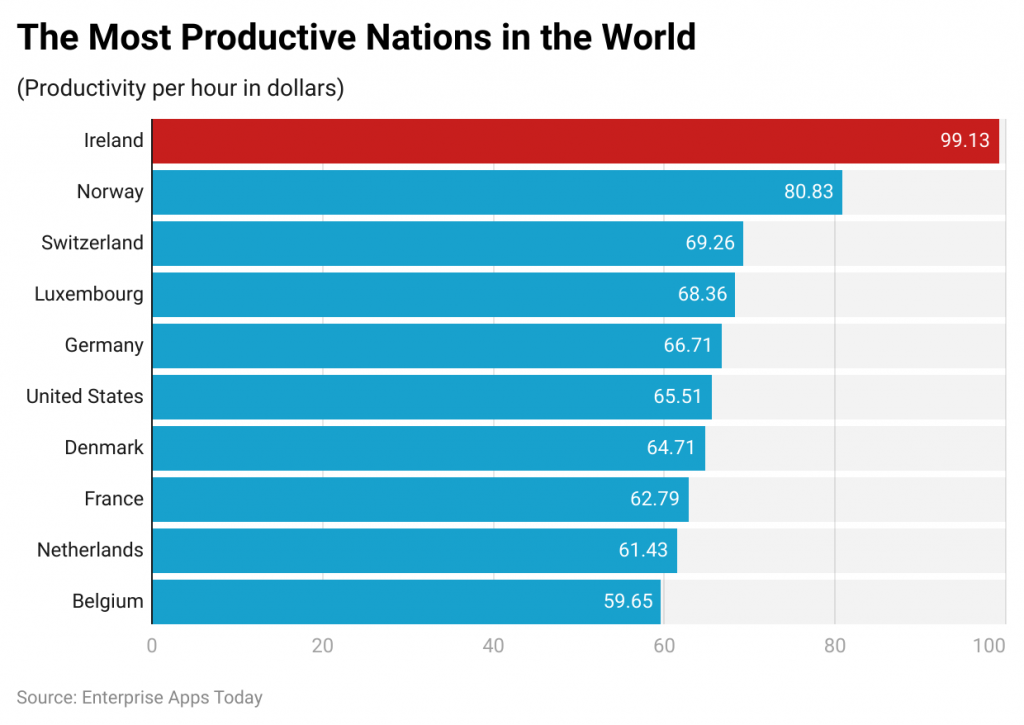 (Source:99firms.com)
(Source:99firms.com)
- As of 2023, across the globe, the most productive nation is Ireland with $99.13 per hour productivity and 39.7 hours per week.
- Per-hour productivity statistics by other nations are followed by Norway ($80.83), Switzerland ($69.26), Luxembourg ($68.36), Germany ($66.71), United States ($65.51), Denmark ($64.71), France ($62.79), Netherlands ($61.43), and Belgium ($59.65).
Employee Productivity over Time Statistics
While productivity has grown over time, technology has provided more distractions than ever before. Regardless, the workers in the United States are now more productive than ever before. Keeping that in mind, where will productivity go? These are some important facts:
#18. Microsoft 365, also known as Microsoft Office, is the most widely used productivity software.
This includes various things such as PowerPoint, Outlook, Excel, and Word. Because Microsoft 365 is cloud-based, tracking, storing, and moving the data is simple.
#19. The market for productivity management software is anticipated to grow at a CAGR of 14.2% between 2021 and 2028.
This technology-based productivity market currently has a value of $42.62 billion. This number is projected to reach $119.69 million by 2028.
#20. Productivity rose by 161.8% between 1979 and 2020.
However, it is interesting to note that this increase in productivity hasn't been matched with similar wage growth because wages increased by around 17.5%. Furthermore, technology is responsible for the majority of this growth since workers are now more distracted than ever.
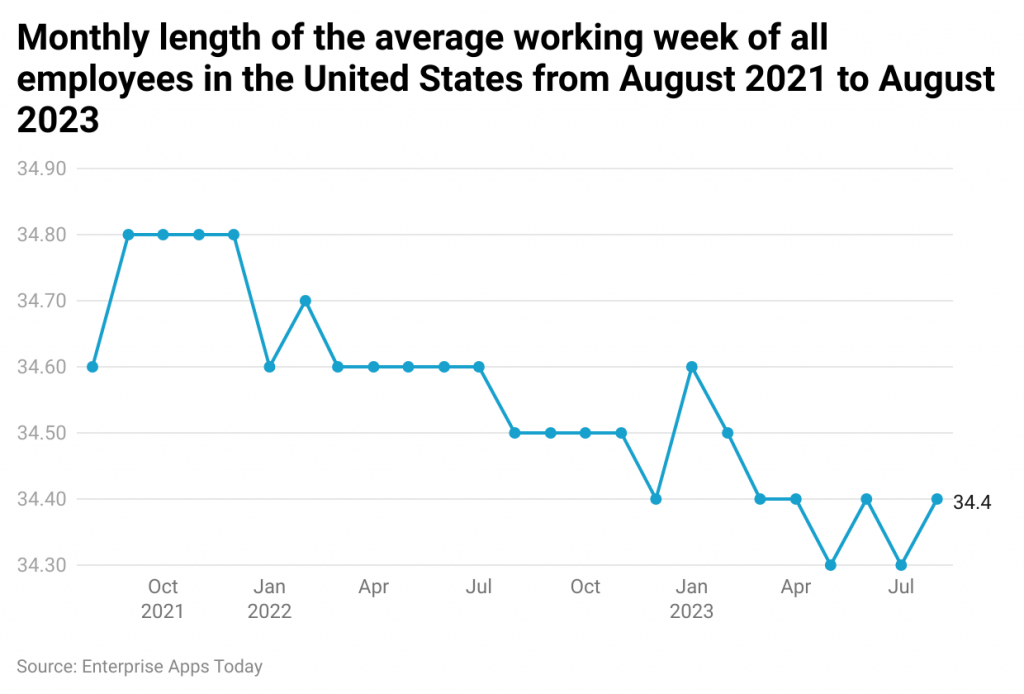 (Source: Statista.com)
(Source: Statista.com)
- As of January 2023, the average working time of employees per week in the United States was 4.6 hours in private non-farm sectors.
- Other weekly working time are followed by February (34.5 hours), March and April (34.4 hours) each, May (34.3 hours), June (34.4 hours), July (34.3 hours), and August (4.4 hours).
Conclusion
In terms of productivity, employees in the United States are both more distracted and more productive than ever before. The truth is that the average worker in the US is productive for only 2 hours and 53 minutes per day, despite the fact that productivity has surged by 161.8% since 1979.
Technology plays a significant role in both of these areas. For instance, various productivity tools such as Microsoft 365 and others have made it simpler than ever to streamline the office. The productivity management software market is predicted to increase by nearly 14.2% through 2028.
However, 47% of workers also admit to using social media at the workplace, and they spend an average of 2 hours & 35 minutes each day, or nearly 32% of their workday, on it.
In light of this, it is clear that distractions are a problem in the workplace. Additionally, companies aren't sure how to resolve this problem.
However, there are encouraging signs among remote and freelance employees, who are more productive for 87% of the workday and around 13% higher productive overall.
Sources
FAQ.
Calculating productivity growth is simple, although a few steps are involved. Let's suppose a company has implemented new policies in order to increase production by 2021. The following steps could be used to calculate how their productivity has changed:
Use this equation to calculate the current productivity level:- Number of units completed / Hours spent to complete each unit (For example, in 2021, there were 6 units completed / 3 hrs = 2 units were produced per hour).
Use the same procedure to calculate prior productivity:- In 2020, 6 units / 4 hrs = 1.5 units were produced each hour.
Subtracting the previous rate from the new rate:- 2 - 1.5 = 0.5 production increase.
Calculate difference in percent:- Production increase / Old production number X 100 ( For example, 0.5 / 1.5 = 0.33x100 = 33%).
In this case, making improvements results in a 33% increase in production.
A productivity analysis is a procedure that gathers information to identify ways to boost productivity. Employers usually use a productivity analysis to pinpoint their workers' strong and weak points.
For instance, can assist in establishing the following:
Find opportunities for cost savings
Assess the effectiveness of present operations
Valuable vs. non-valuable work
Identify more efficient ways of performing the task.
Then organizations can use that information to create goals, eliminate unnecessary work, and reduce costs. These are all essential types of streamlining for any kind of business.
The average employee in the United States is productive for only 2 hours & 53 minutes per day. That's only 31% of the average 8-hour work day. Employees are also aware of this, as only 7% of them feel productive at work.
However, this does not imply that productivity has dropped or is at an all-time low. On the other hand, overall productivity has increased by 61.8%.
A correct productivity percentage is between 70 to 75%. This indicates that employees work for at least 70% of the day and only take breaks for no more than 25% of the time. This enables maximum profit without running the danger of burnout or a wrong work-life balance.
But as you may have seen, this is not normal. The average Americans are productive for up to 60% of the time. In contrast, office workers are only productive for nearly 31% of the time, and freelance employees are productive for an astounding 87% of the time.
Productivity can be calculated by comparing the number of products and services produced with the inputs mainly used in the production. This procedure most frequently and accurately carried out by the BLS (The Bureau of Labor Statistics).
Therefore, labor productivity is the ratio of the services and products output to the number of hours spent producing that output.
A productivity expectation of 75% indicates that the worker is not constantly working at maximum capacity and exhausting themselves. In this manner, if demands momentarily increase, they can respond effectively without exceeding their limits.
For instance, a worker who works at 75% of capacity will have vacations, unscheduled time during the day, and minor breaks. This will give the worker more energy when it is time to work and lead to a consistent and healthy productivity rate.

Michael Singer is a career coach, podcast host, and author to help you step into a career you're excited about. Currently, He is a coach and trainer helping entrepreneurs and executives achieve business and leadership success. He is also an award-winning business journalist focused on the intersection of technology, Big Data, Cloud, SaaS, SAP, and other trending technology.